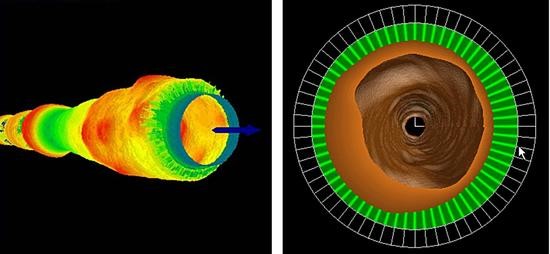HGH’s award-winning KILNSCAN has been performing preventative maintenance for rotary kilns for more than two decades. Let’s highlight the main features that impact upon product quality and risk management in the clinker production process.
The use of infrared scanners to monitor temperature changes on rotary kiln shells in real-time is relatively recent. This technology has only been available for a few decades and it has spread very quickly in the industry, becoming a central element to the operation of the cement plant maintenance teams. With more than 1000 units sold worldwide, HGH’s KILNSCAN thermal scanner works to ensure uninterrupted operation of the cement production line, avoiding unplanned shutdowns and kiln refractory failures, which can result in several days of lost production and impact upon operational costs.
The scanner provides real-time visualization and analysis of the thermal map over the full rotary kiln shell. This article will outline the main features that impact upon product quality and risk management in the clinker production process.
Rotary kiln shell temperature monitoring systems are sensitive to infrared radiation, emitted by all objects. The measurement is therefore taken without contact, and from a relatively considerable distance, with scanners installed tens of metres from the kiln. As the system is not exposed to high temperatures, its service life is extended. Some HGH infrared scanners have been in operation for more than 20 years. Installation workers also appreciate the long distance from the heat source during the commissioning of the scanner.
KILNSCAN scans up to 25 lines per second on the entire length of the kiln. As the kiln itself is constantly rotating around its axis, at a speed of several revolutions per minute, the infrared scanner displays a complete thermal map of the shell, which is continuously updated. Any thermal evolution will be easily detected and highlighted. No hot spot, even temporary, will go unnoticed.
However, this measure must be sufficiently accurate. Accuracy is the ultimate feature that can differentiate an effective scanner from a poor one. The key characteristics to be taken into account here are the spatial resolution of the instrument and its thermal sensitivity. The spatial resolution is the ability to distinguish two hot spots close together on the kiln shell. KILNSCAN has a resolution smaller than the size of refractory brick; thereby the scanner will be able to detect a single brick falling within the kiln. KILNSCAN’s thermal sensitivity allows it to separate two close temperatures. The scanner has a thermal sensitivity better than 0.05 °c, meaning that even the lowest rise in temperature will be immediately identified. Due to these two essential features, which can be connected to a configurable alarm system, maintenance operators will be notified as soon as possible of any emergency and will be able to react quickly to avoid irreversible damage.
A thermal scanner is much more than a simple device to alert plant personnel to falling bricks in the kiln. The evolution of the general geometry of the kiln shell is also an important indicator to take into account. This metal cylinder is subject to high temperatures and mechanical pressure from the support rollers. Shell distortion has implications for the resistance of refractory bricks and for the deformation of tyres and roller stations. It also reflects the global fatigue of the shell. KILNSCAN enables the monitoring of tyre slip (e.g. the clearence between the tyre and the shell outer surface) which must be greater than a few millimeters to avoid any constriction.
The evolution of tyre slip is a good indication of the shell expansion or out-of-round. However, it is not sufficient to evaluate the global distortion of the kiln. In addition to this measure, KILNSCAN provides a unique advanced feature: the calculation of the thermal warp. This function visualises the kiln axis distortion due to internal temperature gradients. The operator can receive information on mechanical stresses supported by the kiln shell, the tyres and the roller stations, and then try to minimise them by optimising parameters such as the combustion flame adjustment. The thermal warp computation also provides information on the distribution of the clinker and the coating inside the kiln.
As the main objective of cement plant personnel must be the production of cement and not to become infrared experts, the measurement results, as complete and accurate they are, should be as accessible as possible. Here are a few screenshots to illustrate this aspect:

Just below the thermal map is the section for the refractory management, displaying detailed information regarding the position, type and date of installation of all the bricks inside the kiln shell.
The thermal warp overview is presented in the middle, with the visualisation of the distorted axis in real-time and the minimum and maximum envelop curves.
The thermal profile is located at the bottom of the screen, displaying envelop and mean curves, and bar graphs showing tyres slip and associated alarms (the bar graph colour turns to red when the alarm threshold is exceeded).
Next pictures illustrate typical software displays: 3D view of thermal and coating profiles, historical data & trends management.


In conclusion, the KILNSCAN thermal scanner is a diagnostic tool that goes far beyond just controlling a few temperature points. It provides a complete visualisation, with high resolution and high sensitivity, of the kiln shell thermal map. Due to the user-friendly software, alarm thresholds can be easily applied to the temperature profile, to immediately deal with falling brick or coating losses. In addition, the thermal warp overall view (displaying the distortion of the Thermo-mechanical axis) and the tyre slip monitoring make it easier to anticipate medium-term kiln fatigue, as well as its possible consequences on the tyre shape, roller shafts and piers. Preventive actions, such as changing flame intensity, using alternative fuel, or resurfacing tyres and rollers, can then be set up and their effectiveness assessed. The KILNSCAN software also includes the historical management of all measured data. The long term monitoring of each parameter, the comparison to reference level and the display of trend lines are functions that can be used to consolidate multi-year maintenance plans.






